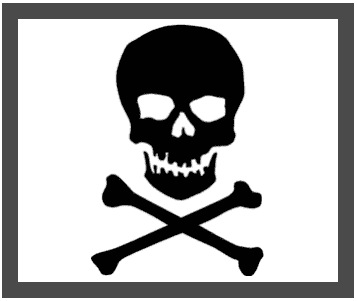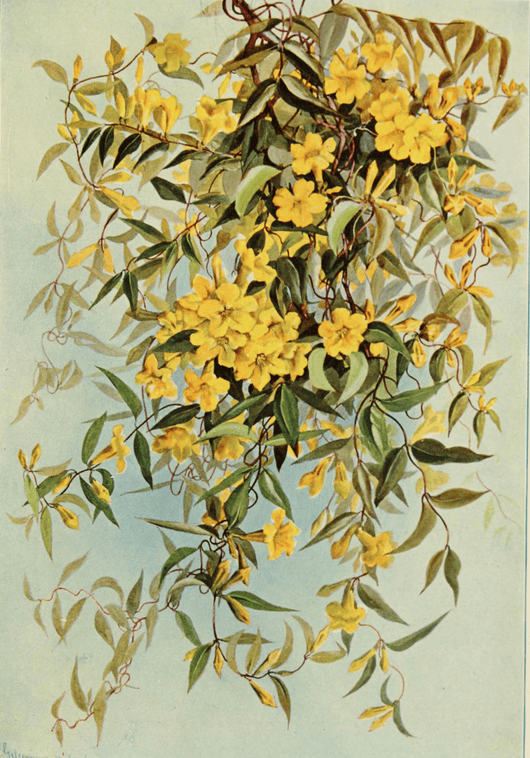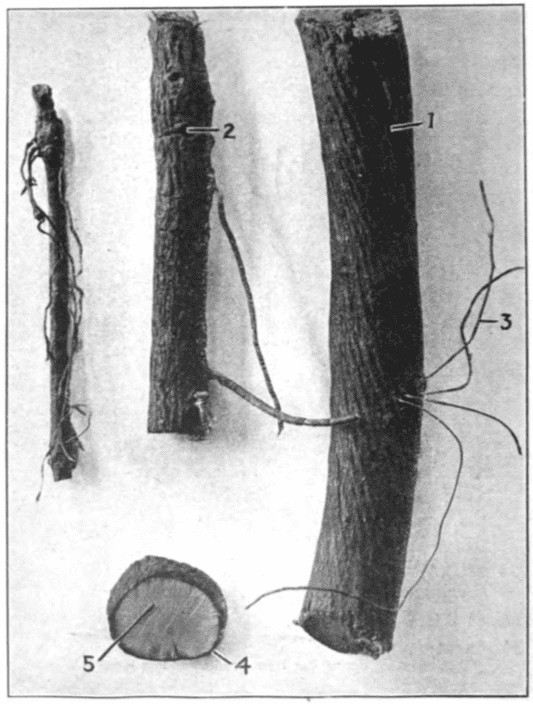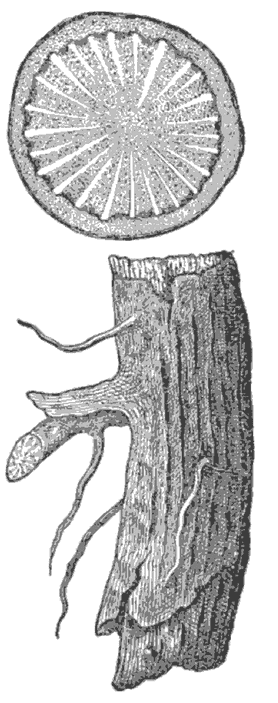Gelsemium, Yellow JasmineYellow Jasmine, Yellow Jessamine, Carolina Wild Woodbine, Evening Trumpet FlowerGou Wen (TCM) |

|

|
 Gelsemium sempervirens
Gelsemium sempervirensLounsberry, Southern wild flowers and trees (1901)

|

|
|
Gelsemium root 1. A twisted, split and striated root; 2. Small fissures beginning at the root scar; 3. Small wiry root; 4. Thin cortex; 5. Thick, finely radiate wood. (Squibb’s Atlas of the Official Drugs, Mansfield, 1919) |
Gelsemium root Notes on Pharmacognosy, Otto Augustus Wall, 1902 |
Botanical name:
Gelsemium sempervirens
Other species are used similarly.
See also Gelsemium elegans, used in TCM.
Parts used:
Root and Rhizome, gathered just before the flowers open.
Various practitioners said the fresh root is best
Temperature & Taste:
Warm, dry. Bitter, Pungent. Toxic
Classifications:
2R. NARCOTICS & HYPNOTICS
Uses:
1. Settles Wind, Stops Spasm, Eases Pain:
-various forms of Neuralgia (internally and externally) including Facial Neuralgia, Trigeminal Neuralgia, Toothache
-Nervous Headache, Vertigo; Tinnitus (King)
-Arthritis, Rheumatism (internally and externally)
-Back pain (3–8 drops of the tincture has been injected into the seat of the pain)
-Tetanus
-Palpitations, Insomnia
-Nocturnal Emission (of a nervous nature)
-Anxiety (anxiolytic effects were noted in mice even at ultra-low doses)
-Alcoholism, Opium addiction etc. (Dr. Parrish, Philadelphia)
2. Resists Poison, Resolves Swellings:
-Colds. Flu, Fever, Remittent Fever
-Inflammations
-Cerebrospinal Meningitis (Eli Jones); Pneumonia (King)
-Pharyngitis, Diphtheria
-Eczema, Furuncle
-Scrofula, Glandular Swellings
-also used for Cancer (in China)
3. Moves the Blood, Clears Stasis, Eases Pain:
-Amenorrhea, Dysmenorrhea
-spasmodic pain of the Uterus
-Endometriosis, Uterine Fibroids (with other remedies)
-Metritis
-After pains following labor
4. Externally:
-applied to Neuralgia and Rheumatism (Tincture)
Dose:
1. Generally today its use is restricted to external use.
2. Tincture was the preferred mode of use internally.
3. Begin with very low doses, increasing as needed. Add 1 drop of the tincture to 50 mls of water. Give a teaspoon as a dose, increasing to 2 teaspoonfuls, then 3. This way, dose can be gradually increased safely.
Powder: 100–500mg (Squibb’s lists 30mg doses)
Tincture: 10–50 drops (King); a good way to use it is to add 10–30 drops in 4 oz. of water, a teaspoonful being taken every 1–3 hours. For more urgent cases, such as Convulsions, 5–15 drop doses have been given every 15 minutes–1 hour.
Fresh Root Tincture (1:2 in 95% alcohol): 1/10th–10 drops
Dry Root Tincture (1:10 in 50% alcohol): 1/10th–10 drops
Fluid Extract: 0.03 ml (half minim)
Dry Extract: 10 mg
Comment:
King noted that it is apt to cause clouded vision, double vision, and even inability to open the eyes which can last a few hours, leaving the patient feeling refreshed after. He also states that as soon as a heaviness or partial closure of the eyes is produced, no more should be given.
Substitutes:
It is therapeutically similar to Conium, Digitalis, Aconite and Veratrum
Main Combinations:
Several Practitioners, especially Eli Jones, regarded Gelsemium and Cimicifuga as working well together.
1. Headache, Neuralgia, Gelsemium, Cimicifuga (20 drops of each), Water (4 oz.). Mix. 1 teaspoonful every hour (Eli Jones)
2. Spasms, Tetanus, Gelsemium (20 drops), Passionflower tincture (1 dram), Water (4 oz). Mix. 1 teaspoonful every hour. (Eli Jones)
3. Cerebral Irritation, Gelsemium, Scullcap, Passion flower
4. Delirium, Gelsemium with Veratrum (Scudder)
5. Idiopathic Tetanus, Gelsemium tincture (20 drops), Water (6 oz.). 1 teaspoonful every hour. (Eli Jones)
6. Neurasthenia in Women, with palpitations, shortness of breath, chest pain, Cimicifuga tincture, Gelsemium tincture, Pulsatilla tincture (20 drops each), Water (6 oz). Mix. Take 1 teaspoonful every 2 hours. (Eli Jones)
7. Pharyngitis or Diphtheria, Gelsemium tincture, Poke root tincture (20 drops each), Water (4 oz). Mix. 1 teaspoonful every hour. (Eli Jones)
8. Asthma, Gelsemium, Sumbul. Give 8 drops of each tincture in a tablespoon of water every 15 minutes (Eli Jones)
9. Puerperal Peritonitis, Gelsemium, Cimicifuga (20 drops of each), Water (4 oz.). Mix. 1 teaspoonful every half hour, applying Hops and Wormwood steeped in vinegar over the abdomen (Eli Jones)
10. Gout, Rheumatism:
i. Gelsemium with Guaiacum or Colchicum (King)
ii. Muscular Rheumatism, Gelsemium, Cimicifuga (20 drops of each), Water (4 oz.). Mix. 1 teaspoonful every half hour, (Eli Jones)
11. Lumbago, Gelsemium tincture, Cimicifuga tincture, Bryony tincture (half dram each). Mix. Take 10 drops every half hour.
12. Cystitis, Tincture of Aconite (10 drops), Gelsemium tincture (half dram), Sweet Spirits of Niter (1 oz), Water (qs to make 6 oz). Mix. Take a teaspoonful every hour. (Eli Jones)
13. Gonorrhea, Gelsemium tincture, Cannabis tincture (half dram each), Sweet Spirits of Niter (1 oz), Water (qs to make 6 oz). Mix. Take a teaspoonful every hour. (Eli Jones)
14. Acute Prostatitis, Gelsemium tincture with Stavesacre tincture (Eli Jones)
15. Influenza, Fluid Extract of Gelsemium (30 drops), Fluid Extract of Aconite (6 drops), Water (4 teablespoonful). Mix. (Vitalogy, 1906)
16. Chorea, Gelsemium, Cimicifuga (20 drops of each), Fowler’s Solution of Arsenic (30 drops). Mix. 1 teaspoonful every 3 hours
17. Pain of passing Gall Stones, Gelsemium with Wild Yam. (King)
18. Proctitis with fullness, burning and throbbing of the rectum, Gelsemium tincture, Collinsonia tincture (20 drops each), Water (6 oz). Mix. One teaspoonful every half hour for two hours ; then a teaspoonful every hour. (Eli Jones)
19. Dysmenorrhea:
i. Blue Cohosh tincture, Gelsemium tincture
ii. Tinctures of Gelsemium (1 dram), Tincture of Aconite (16 drops), Fluid Extract of Ergot (7 drams)
iii. Gelsemium, Cannabis
20. Endometriosis and Uterine Fibroids, Gelsemium, Aconitum napellus, Bryony, Poke root (Turska’s Formula)
21. After pains, Gelsemium tincture (20 drops) in a glass of water. Mix. Give a teaspoonful every half hour. (Eli Jones)
Major Formulas:
Cautions:
1. Toxic in Overdose. Contains toxic indole alkaloids.
2. Avoid in Pregnancy and Lactation. Avoid use in the young, old or weak.
3. Avoid in those with weak and slow pulse, bradycardia, congestive heart failure, senile heart, emphysema
4. Not used in congestive fever. (King)
5. ‘Contra-indicated when eyes are dull, pupils dilated and circulation feeble. Under these circumstances it is poison even in small doses’. (Materia Medica and Clinical Therapeutics, Petersen, 1905)
Toxicity:
Large doses cause muscular paralysis, pulse rate and respiration are slowed. This is followed by vertigo, staggering, double vision, drooping of the lower jaw, dilated pupils; pulse weak or intermittent, low temperature, breathing difficulty; death comes from respiratory paralysis. Consciousness remains until carbon dioxide narcosis sets in.
Incompatibles:
Opium, Belladonna, Atropine
Antidotes:
1. Belladonna and Digitalis are physiological antidotes.
2. Brandy, Quinine or Aromatic Spirits of Ammonia.
Main Preparations used:
Tincture
1. Tincture of Gelsemium:
Fresh Gelsemium root 4 oz.
Dilute Alcohol 1 pint
Macerate 14 days, press and filter.
Dose: 10 drops–1 fluid dram (King)
-
Extra Info
-
History
|
‘The yellow jessamine of the southern United States grows from Virginia southward, extending into Mexico. It flowers in March and April, and some years a second time, at least I am given to understand that such is the case in the State of Georgia. Although its support somewhat regulates the extent of the growth of this climbing vine, still it extends beyond the limits of the support in such a manner as to form beautiful trails and fringes; this occurs even above trees that are over 50 feet high. The beautiful yellow flowers, the odor of which is said to be narcotic, yield a delightful perfume, which may be extracted by a process similar to that used for procuring oil of rose (Porcher). The medical history of this plant is quite modern, having been brought into notice, according to Dr. King, by a Mississippi planter, for whom in his illness the root was gathered in mistake for that of another plant; |
after partaking of an infusion serious symptoms arose, so alarming in their character that his friends expected his death; upon his revival, however, it was apparent that the attack of bilious fever from which he had been suffering had disappeared. This accidental cure came to the knowledge of a pretender, who prepared a proprietary nostrum from the plant, called the “Electric Febrifuge.” Dr. Porcher, of South Carolina, noting the use of gelsemium in the works of Elliott and Frost, brought it again into notice through the mediumship of a report on the medical botany of his state, made to the Am. Med. Ass’n, in 1849. The first provings were made by Dr. Henry (1852), whose work was followed by many provers, the principal among them being Dr. E. M. Hale, whose ” Monograph on Gelsemium” has been a most efficient help to the true knowledge of this valuable American addition to our medicamentae. (American Medicinal Plants, Millspaugh, 1887) |
